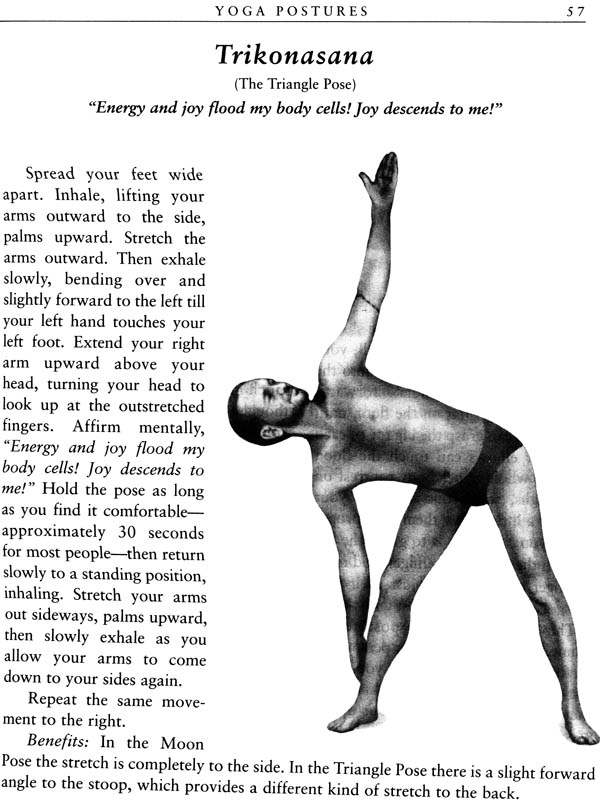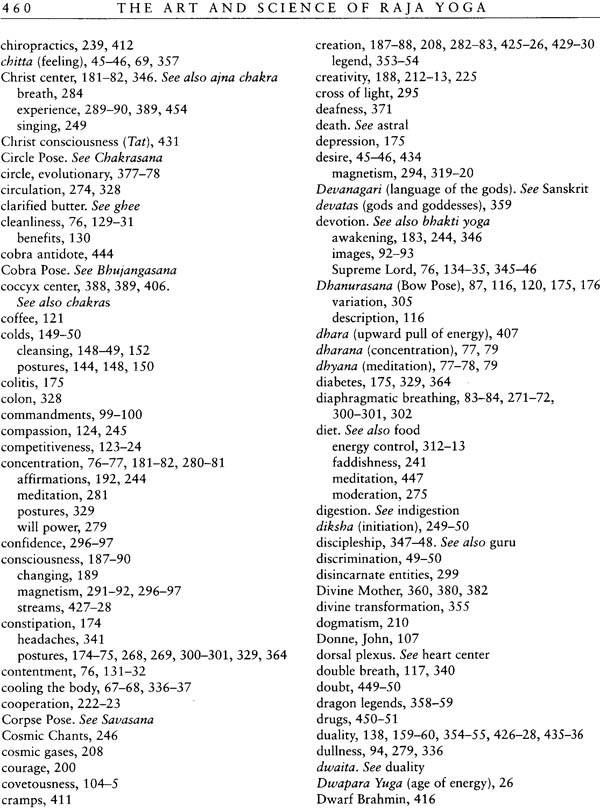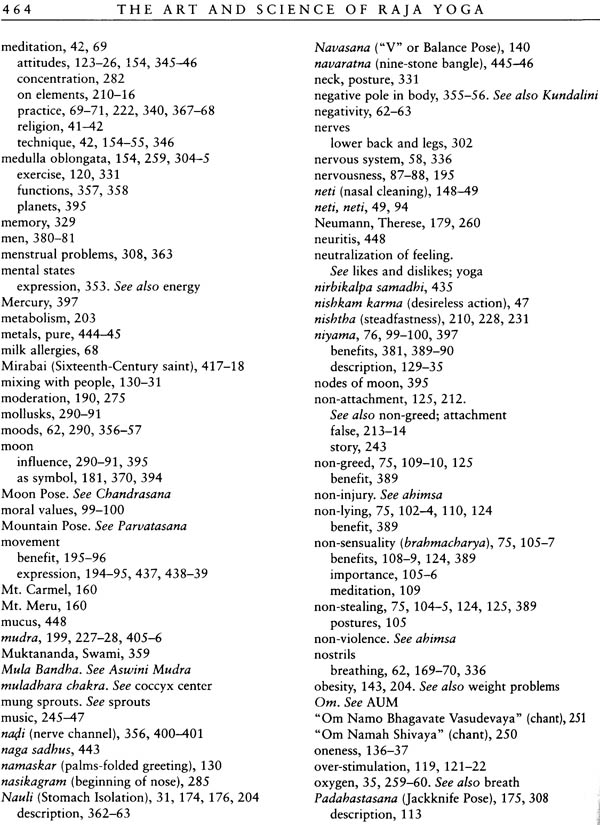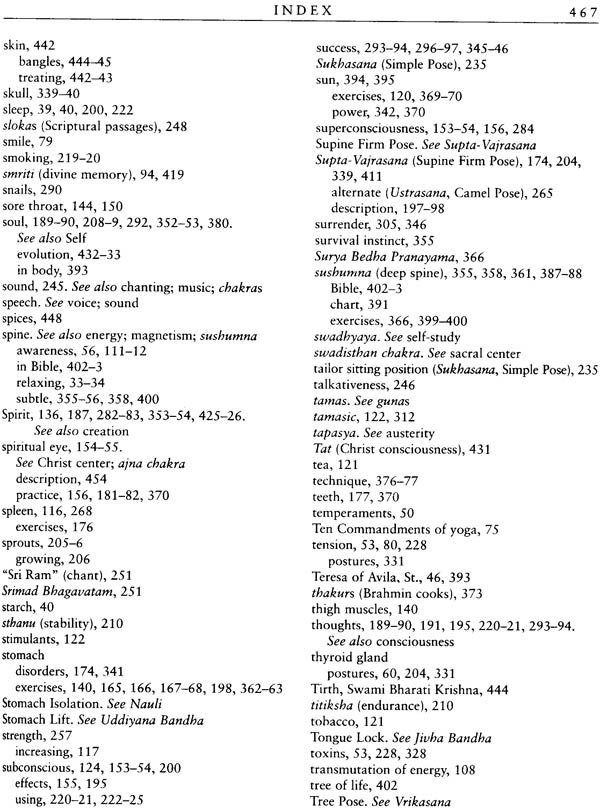Lessons in Meditation the Art and Science of Raja Yoga
The Art and Science of Raja Yoga contains fourteen lessons in which the original yoga science emerges in all of its glory—a proven system for realizing 1'southward spiritual destiny. This is the most comprehensive class on yoga and meditation offered today, giving the yoga educatee a profound and intimate understanding of how to apply these age-old teachings on a practical, as well every bit spiritual, day-to-day level in this modern historic period.
Over 450 pages of text and photos give you a complete and detailed presentation of hatha yoga (yoga postures), yoga philosophy, affirmations, meditation, and animate techniques. Also included are suggestions for daily yoga routines, helpful data on diet and alternative healing techniques- Apply these teachings and techniques in your daily life and yous volition attain your highest soul potential: truthful happiness, inner peace, and the dynamic joy of your soul. "I've studied many books in hopes of finding one that would modify my life, showing me how to be a happy, contented person. This book has been the 1. It has taught me how to access peace from inside my Self It is a manual I will study again and once more for its depthless teachings."
P.B., Dallas, TX
"The lessons themselves are so rich that I learn something new every time I read them."
KM., Ojai, CA
"I must say the results are more than I expected. My friends say I'thou glowing. I seem to have nearly limitless free energy."
P.O., Dundee, FL
"Christ said 'you will know truth by the fruit that it bears.' The Xiv Steps to Higher Sensation is a writing of Truth. The fruits of incorporating the teachings of Yogananda into my life have been concrete, emotional, and spiritual healing."
C.S., Fresno, CA
"The depth of cognition I've gained is exactly what I was seeking. Since I started the teachings, I have noticed a significant difference in the quality of my life. I feel more than relaxed, more at peace, and sometimes detect myself smiling with a joy that bubbles from inside."
In The Art and Scientific discipline of Raja Yoga, the original yoga science emerges in all of its celebrity—a proven system for realizing our spiritual destiny. The practice of raja yoga awakens united states of america to our deepest reality of oneness with the Infinite. The primal word here is practise. Equally a spiritual science, yoga is unique in that information technology encourages us to test the truth of its principles, non but to believe. Using the many tools yoga gives us, we can make up one's mind showtime-mitt whether information technology does in fact live up to its glorious hope. The "proof" comes in our growing experience of the honey, joy, calmness, and courage of our soul nature. Yoga is thus empowering. It gives the states the teachings, the tools, and the validation of our ain deepening experience of the Divine to speed u.s. on our inner journey to God.
The Art and Scientific discipline of Raja Yoga was my first systematic introduction to yoga. Xx-one years later, I am securely grateful for this course and the opportunity to recommend it to others. Swami Kriyananda is a direct disciple of Paramhansa Yogananda, author of the spiritual archetype, Autobiography of a Yogi. Yogananda, the kickoff yoga master to live and teach in the West, brought with him the authentic, original yoga science of aboriginal India. For more than fifty years, Kriyananda has devoted his life to sharing these same teachings. The joyful enthusiasm with which he does and so is a compelling invitation to yoga'south inner journey.
The Art and Science of Raja Yoga give us the counterbalanced, comprehensive approach of raja yoga, which is too known equally the "majestic" yoga. The course is organized around vii topics— Philosophy, Meditation, Postures, Breathing, Routines, Healing Principles and Techniques, and Diet. Information technology also includes in-depth discussions of the paths of karma, bhakti, and gyana yoga. Kriyananda excels in showing the interdependence of these seemingly split up areas and how all of them, when correctly approached, further our spiritual progress.
The primary purpose of yoga postures, for instance, sometimes thought to bestow only physical benefits, is to prepare the body and mind for meditation. Affirmations, visualizations, breathing exercises, healing techniques, the different paths of yoga, and, to a certain extent, diet are similarly helpful. What unites these diverse areas is raja yoga's inwards, spiritual focus, which achieves its fullest expression in the practice of meditation. Meditation, as taught in The Art and Science of Raja Yoga, gives us direct access to the inner world of Spirit. In the truest possible sense, meditation is yoga'southward laboratory and the primary means by which nosotros test the truth of its teachings.
To prepare for the practice of meditation, the course offers numerous preliminary exercises that assist usa make the transition from the outer world of action to the inner world of stillness. We learn how to let get of worries, physical and mental tension, and to focus the heed—skills that are helpful not but for meditation just equally in our daily lives. The meditation techniques of ancient Republic of india, presented by Kriyananda in step-past-pace detail, turn out to be indispensable for quieting the mind, drawing it inward, and redirecting our awareness to the centers of spiritual awakening in the brain. Proper meditation, one presently discovers, is neither mechanical nor passive, but requires deep concentration and sustained, dynamic energy.
Meditation requires also what Kriyananda calls a "complete revolution" in "what are commonly looked upon every bit normal man attitudes." He explains: "The competitive bulldoze, for instance, implies an assumption that success must always be exclusive, even to the extent of beingness determined by other people'south failures. . . . Such an attitude volition thwart the virtually earnest of efforts to progress in meditation, for it will pit i confronting the universe instead of harmonizing him with information technology. Right attitude is essential to right meditation."
The "right attitudes" referred to by Kriyananda are the universal moral principles of yoga, the yamas (the don'ts) and niyamas (the do'southward). One of the best known of these is ahimsa, or non-injury, popularized by the protest movements of Gandhi and Martin Luther Rex, Jr. Ahimsa's proscriptions are directed not only against harmful actions, merely also the damage caused by negative thoughts. The reasons go the heart of yoga. Kriyananda writes:
"The first step in the development of correct mental attitude is to learn to see others not as rivals, just as friends. . . . The goal of yoga is to realize the oneness of all life. If I am willing to hurt the life in me every bit information technology is expressed in another human being beingness, and then I am affirming an fault that is diametrically opposed to the realization I am seeking to achieve. It is necessary if I would truly realize the oneness of all things, for me to live also in a way equally constantly to affirm this oneness—by my kindness toward all beings, by compassion, by universal dearest."
To experience the deeper states of meditation where Spirit resides, we must first put ourselves on its wavelength. Kriyananda advises that at the start of each meditation, we ship out waves of forgiveness from the heart to those nosotros may demand to forgive. This helps us to resolve conscious and subconscious feelings of anger that draw the mind outward, and to chronicle to the people involved with more than kindness and understanding. Past affirming dear for all beings, nosotros open ourselves to the gentle vibrations of divine love. Increasingly, equally nosotros practice the yamas and niyamas, in our daily lives and every bit role of our meditation, our journeying to the Divine becomes not only a search for love but besides its expression.
We are encouraged, also, to view yoga's moral principles as directional, their perfection as the end not the showtime of the journeying. We can gain considerably in peace of mind and inner strength long before we actually perfect our attitudes. India's great scripture, the Bhagavad Gita, offers the comforting reassurance that "even a niggling practice of this inwards religion will save you from dire fears and colossal suffering."
Another bailiwick thoroughly covered in this comprehensive course and equally basic to an understanding of yoga is energy. Thing in its essence is energy. Even the homo body is not what it seems. Though superficially equanimous of flesh and bones, on a deeper level of reality it is composed of energy. Western scientists uncovered this truth only in the last century, merely it has been known to the yoga tradition for thousands of years. According to Indian scriptures, the Earth repeatedly goes through cycles of higher and lower levels of spiritual understanding. Yoga originated in a higher historic period when ordinary people could grasp truths that modern science is only now discovering.
Countless vortices of energy brand upwardly our deeper reality. When these vortices work together in harmony we are good for you, happy, and life affirming. If we are unwell, depressed, or life negating, it is primarily because our free energy is low, or because these vortices are out of sync with one another. The Fine art and Science of Raja Yoga gives us many ways to strengthen this energy and bring it into harmony—breathing exercises, healing techniques, yoga postures, affirmations, visualizations. Meditation, however, is the most powerful. Through meditation we get more than sensitively enlightened of the torso'southward subtle energies and increasingly able to harmonize and redirect this energy.
Until we are well along on yoga's inner journey, Kriyananda advises that we exist careful well-nigh our "energy environment." Equally Paramhansa Yogananda said, "Environment is stronger than will power." Everything we practise influences our energy. An environment of positive people, uplifting music, 'inspiring books and wholesome movies tin can greatly aid our spiritual efforts. Unfortunately, the reverse is also true.
Yoga's more esoteric subjects, such equally the chakras, the role of a guru, and astrology (which evolved as an extension of yoga) are likewise antiseptic in The Art and Science of Raja Yoga. The chakras are only the body'due south energy centers, whirling spheres that distribute energy to various actual areas. When our energy is uplifted, we tap into the spiritualizing influence of the higher chakras. Contrary to popular opinion, the influence of a guru is inward, non outward. The guru'southward energy (and that of any highly advanced spiritual teacher) is concentrated in the college chakras.
Merely equally a potent magnet can strengthen a weak 1, and then also does the guru magnetically strengthen and uplift the energy of those who are receptive. Astrology's stars and planets are best understood as outer symbols of the shifting patterns of our inner energy. Through the exercise of yoga, we can lessen the impact of the heavenly bodies by redirecting the inner energy that relates to their movements. We can, that is, outwit the stars!
Yoga means "matrimony." Through diligent practice, raja yoga helps usa to attain unity within ourselves on always- deeper levels, kickoff by bringing body, listen and soul into harmony, and then by expanding our sense of cocky to include all life and creation. "No man is an island," wrote John Donne; life is an interconnected reality. Simply inner harmony and universal kinship are not the stop of our journeying. Life has given us one destiny just—spousal relationship with God. Through yoga we gradually learn to see across our bodies and personalities to the underlying energy and beyond that energy to the divine consciousness that produced us all. The faithful do of raja yoga brings a deepening attunement with that consciousness and ultimately, the realization that we are, and ever have been, 1 with the Infinite.
We'd similar to offer yous a few helpful suggestions as yous begin your study of these materials:
1) Study the lessons at your own stride. Originally these fourteen lessons were mailed out one at a time, every 2 weeks for 20-eight weeks. You may find that two weeks is just most the correct amount of time to spend on each lesson. Possibly you'll desire to go faster! Merely slower might be improve, in social club to have time to actually savor the depths of these teachings, and, more than importantly, to start actually doing them. In a mode, The Fine art and Science of Raja Yoga is a lifetime written report. You tin re-read the book, or parts of it, repeatedly, whenever y'all want to re-inspire yourself to go more deeply into your yoga and meditation practices. The class tin besides exist used as a reference book; you'll discover a comprehensive index at the stop.
ii) Unlike intellectual study, this course tin can offer yous a whole new arroyo to living, if you give information technology focused attention, and then put it into actual practice. Getting a existent experience of yoga and meditation will teach y'all much more than just reading about it.
3) Practice some of the exercises and meditation techniques daily. There are several audiotapes we tin can send you to help guide you. You lot may need to brainstorm your day a fiddling earlier and end your evening activities sooner to exist able to integrate these practices into your daily life. Only don't set unrealistic goals for yourself or discourage yourself past trying to do too much, likewise fast. Fifty-fifty S or 10 minutes a day of meditation volition aid you very much. You tin build up the length of your exercise every bit you brainstorm to enjoy it more than and more.
four) Apply caution with the yoga postures, peculiarly the more than avant-garde ones; in that location are some you may want to avoid if they cause you unusual pain or discomfort or if you are pregnant or have astringent health challenges of some sort. Listen to your body and be sure to check with a qualified yoga instructor if you take any concerns about body safety—we can aid you with this past phone, letter, or e-postal service.
v) If you lot tin prepare aside more than fourth dimension, one time each week, to do more than yoga and meditation—perhaps on weekends—information technology will help your daily practices very much!
6) Endeavour keeping a spiritual journal of your thoughts most detail parts of the lessons that ate meaningful to yous, or means in which you are experiencing spiritual growth.
seven) Permit united states of america know where yous live, and we'll try to observe an Ananda grouping near you, or at to the lowest degree, perhaps, another person who is also taking the Ananda Course. A "study partner" can exist most helpful. Meditating or practicing yoga regularly with others, particularly people who have been at it for longer than yous have, is a very valuable matter to do!
| Foreword | xiii | |
| Suggestion for Report | 17 | |
| Writer's Prefatory Notation | 19 | |
| Footstep 1 – The History of Yoga | ||
| I. Philosophy: The History of Yoga | 23 | |
| 2. Yoga Postures: Special Guidelines Sasamgasana, Bhujangasana, Utkatasana | 30 | |
| III. Animate: Savasana | 35 | |
| IV. Routine | 37 | |
| V. Healing: Insomnia, Office Ane | 38 | |
| VI. Diet: Indisposition, Part Two | 40 | |
| Vii. Meditation | 41 | |
| Step two – The Paths of Yoga | ||
| I. Philosophy: The Paths of Yoga | 45 | |
| Two. Yoga Postures: Bones Principles and Practices, Vrikasana, Chandrasana, Trikonasana, Paschimotanasana, Halasana | 52 | |
| III. Animate | 61 | |
| 4. Routine | 63 | |
| V. Healing: Integration vs. Disintegration | 64 | |
| VI. Diet | 67 | |
| Vii. Meditation | 69 | |
| Footstep 3 – Patanjali'south Ashtanga Yoga: The Eightfold Path | ||
| I. Philosophy: Patanjali's Ashtanga Yoga: The Eightfold Path | 75 | |
| Ii. Yoga Postures: Savasana, Paschimotanasana | 80 | |
| Three. Breathing: Total Yogic Breath | 83 | |
| IV. Routine | 86 | |
| V. Healing: Hypertension and Nervousness | 87 | |
| VI. Nutrition | 89 | |
| Seven. Meditation | 92 | |
| Step 4 – Yama | ||
| I. Philosophy: Yama | 99 | |
| Two. Yoga Postures: Vrikasana, Padahastasana, the Astern Bend, Janushirasana, Dhanurasana | 111 | |
| III. Breathing: Sitkari | 117 | |
| IV. Routine | 118 | |
| Five. Healing: Chronic Fatigue | 119 | |
| VI. Diet | 121 | |
| 7. Meditation | 123 | |
| Step five - Niyama | ||
| I. Philosophy: Niyama | 129 | |
| II. Yoga Postures: Ardha-Dhanurasana, the "Five" Pose, Karnapirasana, Chakrasana, Simhasana | 136 | |
| III. Breathing: The Alternate Breath | 145 | |
| Iv. Routine | 147 | |
| 5. Healing: Respiration Troubles | 148 | |
| VI. Diet: Fasting | 151 | |
| 7. Meditation: Super consciousness | 153 | |
| Step 6 – Life is a Battlefield | ||
| I. Philosophy: Life is a Battlefield | 159 | |
| Two. Yoga Postures: Pavanamuktasana, Uddiyana Bandha, Ardha-Mayurasana, Vajrasana | 163 | |
| III. Animate | 169 | |
| 4. Routing | 171 | |
| V. Healing: Stomach Disorders | 174 | |
| 6. Nutrition | 177 | |
| 7. Meditation: Raising the Inner Energy | 181 | |
| Step seven – Affirmations, Part one | ||
| I. Philosophy: Affirmations, Function i | 187 | |
| II. Yoga Postures: Sasamgasana, Supta-Vajrasana, Viparita Karani | 194 | |
| III. Breathing | 200 | |
| IV. Routine | 202 | |
| V. Healing: Weight Problems | 203 | |
| VI. Nutrition | 205 | |
| 7. Meditation: Meditation on the Elements | 208 | |
| Stride 8 – Affirmations, Role 2 | ||
| I. Philosophy: Affirmations, Part 2 | 219 | |
| II. Yoga Postures: Sitting Poses – Siddhasana, Padmasana, Ardha-Padmasana, Sukhasana | 227 | |
| Three. Breathing | 236 | |
| IV. Routing | 238 | |
| V. Healing | 239 | |
| Half dozen. Diet | 241 | |
| Seven. Meditation: Prayer, Chanting, Japa, and Mantra | 243 | |
| Step nine – Energy and Energization | ||
| I. Philosophy: Energy and Energization | 255 | |
| II. Yoga Postures: Supta-Vajrasana, Ardha-Salabhasana, Ardha-Matsyendrasana, Akarshana Dhanurasana, Garudasana | 264 | |
| III. Breathing: Kapalabhati Pranayama | 271 | |
| IV. Routine | 273 | |
| V. Healing: Circulation and the Blood | 274 | |
| Half dozen. Diet: Simplicity in all Things | 275 | |
| Seven. Meditation: Concentration | 278 | |
| Step 10 – Magnetism | ||
| I. Philosophy: Magnetism | 289 | |
| II. Yoga Postures: Parvatasana, Salabhasana, Matsyasana, Yoga Mudra, Dhanurasana | 299 | |
| Three. Animate | 306 | |
| IV. Routine | 307 | |
| Five. Healing: Sex Issues | 308 | |
| Six. Diet | 312 | |
| Vii. Meditation: A. Hong-Sau Outline | 315 | |
| B. Magnetism | 319 | |
| Step 11 – Guru | ||
| I. Philosophy: Guru | 323 | |
| II. Yoga Postures: The Inverted Poses Sarvangasana, Sethu Bandhasana, Sirshasana | 328 | |
| III. Breathing: Sitali Pranayama | 336 | |
| IV. Routine | 338 | |
| V. Healing: Headaches | 339 | |
| VI. Nutrition | 342 | |
| Vii. Meditation | 345 | |
| Step 12 – The Anatomy of Yoga, Role i | ||
| I. Philosophy: The Anatomy of Yoga, Role 1 | 351 | |
| Ii. Yoga Postures: Avant-garde Poses – Nauli, Mayurasana | 362 | |
| 3. Breathing: Surya Bedha Pranayama | 365 | |
| IV. Routine | 367 | |
| V. Healing: The Optics, Ears, and Teeth | 369 | |
| VI. Diet | 372 | |
| VII. Meditation: Attitude | 376 | |
| Step thirteen – The Beefcake of Yoga, Office 2 | ||
| I. Philosophy: The Anatomy of Yoga, Part 2 | 387 | |
| Ii. Yoga Postures: Kechari Mudra, Aswini Mudra, Jalandhara Bandha, Jivha Bandha | 405 | |
| III. Animate: Jalandhara Bandha, Ujjayi Pranayama | 408 | |
| Iv. Routine | 410 | |
| V. Healing: The Legs and Feet | 411 | |
| VI. Diet | 413 | |
| VII. Meditation: Attitude (connected) | 415 | |
| Footstep xiv – The Yogic Scheme of Life | ||
| I. Philosophy: The Yogic Scheme of Life | 423 | |
| 2. Yoga Postures | 437 | |
| III. Animate | 440 | |
| IV. Routine | 441 | |
| 5. Healing | 442 | |
| Six. Diet: Diet for Meditation | 447 | |
| Vii. Meditation: Signs of Spiritual Progress | 449 | |
| A Farewell to the Student | 455 | |
| About the Author | 456 | |
| Index | 457 | |
| An Overview by Subject Affair | 469 |



























Source: https://www.exoticindiaart.com/book/details/art-and-science-of-raja-yoga-philosophy-meditation-postures-diet-breathing-routines-and-health-old-and-rare-book-nac752/
0 Response to "Lessons in Meditation the Art and Science of Raja Yoga"
Post a Comment